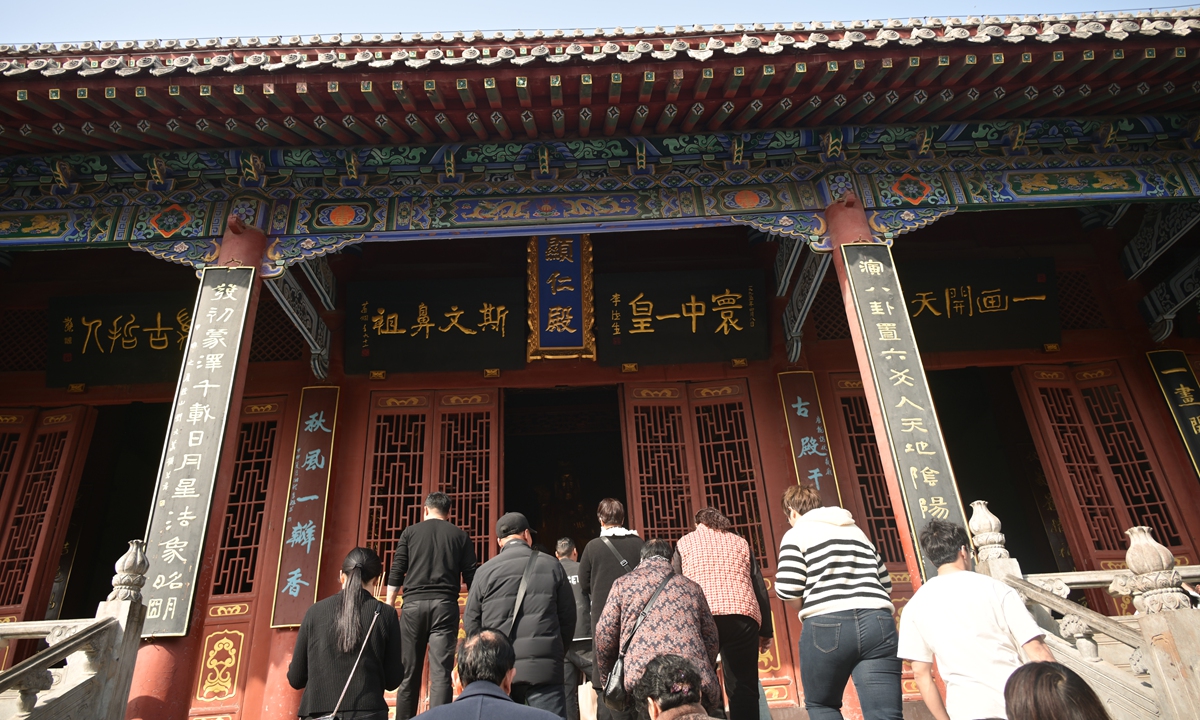
Tourists visit the Taihao Mausoleum on March 11, 2024 in Zhoukou, Henan Province. Photo: IC
The square of the Taihao Mausoleum in Zhoukou, Central China's Henan Province, was bustling with people from far and wide celebrating millennia-old traditions and showcasing the rich cultural heritage of China.
The Taihao Mausoleum is a large ancient architectural complex built to commemorate Taihao Fuxi, the "first of the three sovereigns" and a prominent figure in Chinese mythology.
The Taihao Mausoleum temple fair is held annually from the second day of the second lunar month to the third day of the third lunar month, a period during which people gather together to pay their respects and participate in the grand festivities.
As one of the longest-running, most populous, and oldest temple fairs in China, the Taihao Mausoleum temple fair attracts tens of thousands of domestic and international tourists every year.
In 2008, it was recognized by the Guinness World Records headquarters in Shanghai as the "temple fair with the highest single-day attendance [approximately 825,000]," becoming a Guinness World Record holder.
In 2024, the fair will last to April 11, and it is held under the auspices of the Zhoukou Fuxi Cultural Tourism Festival, witnessing a remarkable convergence of traditional cultural heritage and modern festivities.
The opening ceremony that kicked off on March 10 presented exciting performances for the audience, including national-level intangible cultural heritage projects like Daoqing Opera, and other intangible cultural heritage projects such as Shaolin Kung Fu, Sichuan Opera, Jiangzhou Drum Music, and Yue Tune.
"We set out at 4 am, yet there were already so many people that if you arrived late, you couldn't even find a place to sit," said Gao, a local who lives in the Huaiyang District in Zhoukou.
Gao has been to the temple fair for nearly 40 years since she was a child. "We come here every year. We always keep it in mind," she said.

Tourists flock to the Taihao Mausoleum temple fair on March 11, 2024 in Zhoukou, Henan Province. Photo: IC
Millennial eventHuaiyang is steeped in ancient history as the alleged capital and resting place of Taihao Fuxi, a figure believed to be among the earliest rulers of ancient China, revered as an ancestor of Chinese civilization, and credited with introducing pivotal cultural elements in the region.
It is said that in Huaiyang, he established the concept of the Chinese dragon as a totem, innovated
bagua (the Eight Trigrams), instituted the marriage system, and created surnames. Besides, it was believed that he was also the inventor of writing, fishing and hunting.
The Taihao Mausoleum was constructed in commemoration of Fuxi, and its origins can be traced back to the Tang Dynasty (618-907).
Later, the mausoleum underwent multiple expansions during the Northern Song Dynasty (960-1127) and renovations during the Ming and Qing dynasties (1368-1911).
In 2006, the ceremony in commemoration of Fuxi in Huaiyang was included in the first batch of the national-level intangible cultural heritage list.
The tradition of the Taihao Mausoleum temple fair dates back to ancient times. Initially serving as a venue for young men and women to meet and form marital connections, it gradually evolved into a pilgrimage to pay respects to ancestors.
Today, it has become a beacon of the enduring legacy of Fuxi and the cultural legacy of Henan. In 2024, the main event taking place there adopted the name "Fuxi Cultural Tourism Festival" for the first time.
Tourism festivalIn 2022, a prime location "internet celebrity" stall at the temple fair fetched 980,000 yuan($136,238), igniting a craze for a local snack called "compressed bread."
This year's temple fair saw the compressed bread stall once again securing the coveted top spot, this time with a bid of 260,000 yuan.
Compressed bread, a popular local snack in Huaiyang, has gained market recognition for its chewy texture and delightful taste thanks to its use of high-quality wheat flour from Zhoukou and a biscuit-making technique.
The delicacy is a hit among customers thanks to its taste and affordability. Large ones cost one yuan each, while small ones can be bought for one yuan for three or even more.
Lin, a visitor at the fair told the Global Times that "compressed bread" is a must for her at the fair. She spent 10 yuan buying more than 30 small breads, saying the price was really "reasonable."
Ma Haojun, who won the bidding for the prime stall this year, revealed that she operated three compressed bread stalls at the square during the first lunar month before the official start of the fair.
By March 6, her sales had reached nearly 2 million yuan. "I'm confident that I will break even within half a month," she said.
Many merchants were busy live streaming not only the grandeur of the temple fair but also sending out compressed bread across the country via the internet.
The temple fair has embraced modernity, incorporating elements of digital innovation and cultural entrepreneurship.
The annual temple fair, organized by the local government, has evolved into the Fuxi Cultural Tourism Festival this year, integrating intangible cultural heritage exhibitions, Fuxi book exhibitions, and more.
To attract visitors from other places, during the one month of the temple fair, the entire Huaiyang district provides 6,000 free parking spaces.
All public transit shuttle buses are free of charge, and fines against the transit of out-of-town vehicles will be suspended. Residents are encouraged to give way to tourists from out of town.